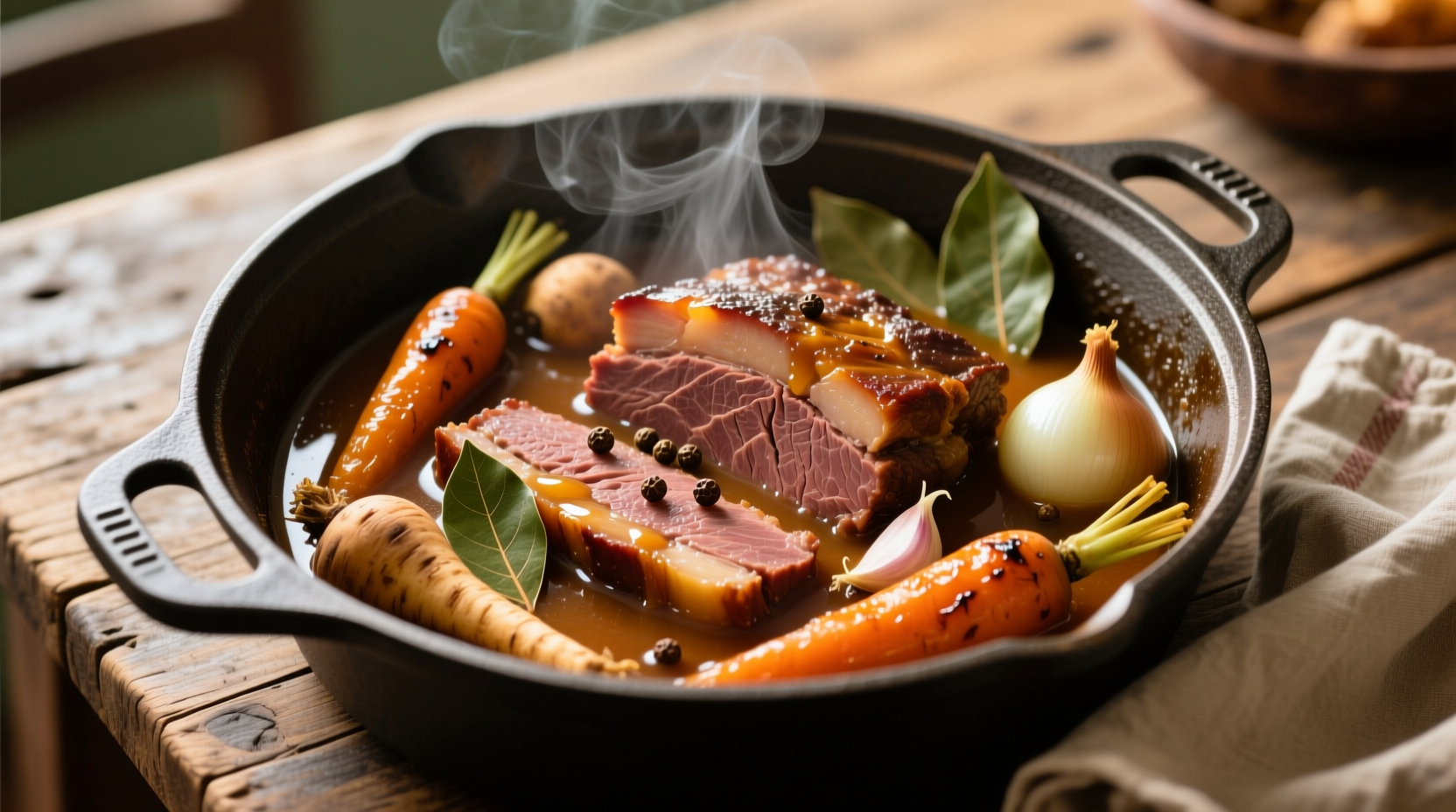Slow cooking corned beef brisket requires 8-10 hours at 225-250°F (107-121°C) with proper liquid coverage and post-cook resting. This method yields fork-tender meat with rich flavor while maintaining food safety standards.
The Ultimate Guide to Slow Cooking Corned Beef Brisket
Nothing beats the comforting aroma of slow-cooked corned beef brisket filling your kitchen. This traditional method transforms tough connective tissue into succulent, melt-in-your-mouth perfection while developing complex flavors. Whether you're preparing for St. Patrick's Day or a comforting weeknight meal, mastering slow cooking techniques ensures restaurant-quality results every time.
Why Slow Cooking Works Best for Corned Beef Brisket
Corned beef brisket comes from the chest area of the cow, making it naturally tough with abundant collagen. Slow cooking at low temperatures (225-250°F) gradually breaks down this collagen into gelatin without drying out the meat. The extended cooking time allows flavors to penetrate deeply while maintaining moisture.
According to USDA Food Safety guidelines, cooking beef to an internal temperature of 145°F with a 3-minute rest ensures safety while preserving tenderness. For brisket, we actually need to go much higher—200-205°F—to fully render the collagen.
Essential Preparation Steps
Proper preparation sets the foundation for perfect results:
- Rinse thoroughly - Remove excess salt by rinsing under cold water for 2 minutes
- Pat dry - Ensures proper browning for enhanced flavor development
- Trim excess fat - Leave 1/4 inch for moisture but remove thick layers
- Prepare aromatics - Classic combination includes 1 onion, 4 garlic cloves, and 2 bay leaves
| Cooking Method | Time Required | Temperature | Best For |
|---|---|---|---|
| Oven Slow Roast | 8-10 hours | 225-250°F | Most consistent results |
| Crockpot | 9-10 hours | Low setting | Hands-off convenience |
| Smoker | 10-12 hours | 225°F | Added smoke flavor |
Step-by-Step Slow Cooking Process
Follow these professional techniques for flawless results:
1. Initial Searing (Optional but Recommended)
Heat 1 tablespoon of oil in a heavy skillet over medium-high heat. Sear the brisket on all sides for 2-3 minutes per side until deeply browned. This Maillard reaction creates complex flavor compounds that enhance the final dish.
2. Liquid Selection and Preparation
The cooking liquid significantly impacts flavor development. Combine:
- 4 cups liquid (water, beer, or broth)
- 1 bottle dark beer (like Guinness) for depth
- 1 cup apple cider vinegar for tenderness
- Spice packet included with corned beef
- Additional spices: 1 tablespoon whole peppercorns, 3 allspice berries

3. Cooking Setup and Temperature Control
Place brisket fat-side up in your slow cooker or roasting pan. Pour liquid mixture over meat, ensuring it covers at least halfway up the brisket. For oven cooking, cover tightly with foil or lid.
Maintain consistent temperature throughout cooking. Fluctuations can lead to uneven results. Use an oven thermometer for accuracy—don't rely solely on your oven's display.
4. Monitoring Cooking Progress
Check periodically (every 3-4 hours) without removing the lid frequently, which causes heat loss. The brisket is done when it reaches 200-205°F internally and a fork slides in with almost no resistance.
According to the American Meat Science Association, connective tissue breakdown occurs most effectively between 190-205°F. Cooking below this range leaves the meat tough; exceeding it risks drying out the meat.
Critical Finishing Techniques
What you do after cooking determines final texture and flavor:
Resting Period
Remove brisket from cooking liquid and let rest, tented with foil, for 20-30 minutes. This allows juices to redistribute throughout the meat. Skipping this step causes precious juices to escape when slicing.
Proper Slicing Method
Always slice against the grain for maximum tenderness. Identify the direction of the muscle fibers and cut perpendicular to them. For brisket, this typically means slicing across the shorter width of the meat.
Troubleshooting Common Issues
Even experienced cooks encounter challenges. Here's how to fix them:
- Too salty - Soak in cold water for 30 minutes before cooking or use low-sodium broth in cooking liquid
- Tough texture - Continue cooking until internal temperature reaches 200°F; don't rush the process
- Dry results - Ensure adequate liquid coverage during cooking; avoid boiling temperatures
- Bland flavor - Add additional spices during the last 2 hours of cooking
Perfect Pairings and Serving Suggestions
Serve your perfectly cooked corned beef brisket with these traditional accompaniments:
- Steamed cabbage with caraway seeds
- Irish soda bread
- Roasted root vegetables (potatoes, carrots, parsnips)
- Mustard sauce (1/2 cup mayonnaise, 2 tbsp Dijon mustard, 1 tbsp horseradish)
For optimal flavor development, consider making your corned beef one day ahead. The flavors deepen when refrigerated overnight, and the fat solidifies for easier removal before reheating.











 浙公网安备
33010002000092号
浙公网安备
33010002000092号 浙B2-20120091-4
浙B2-20120091-4